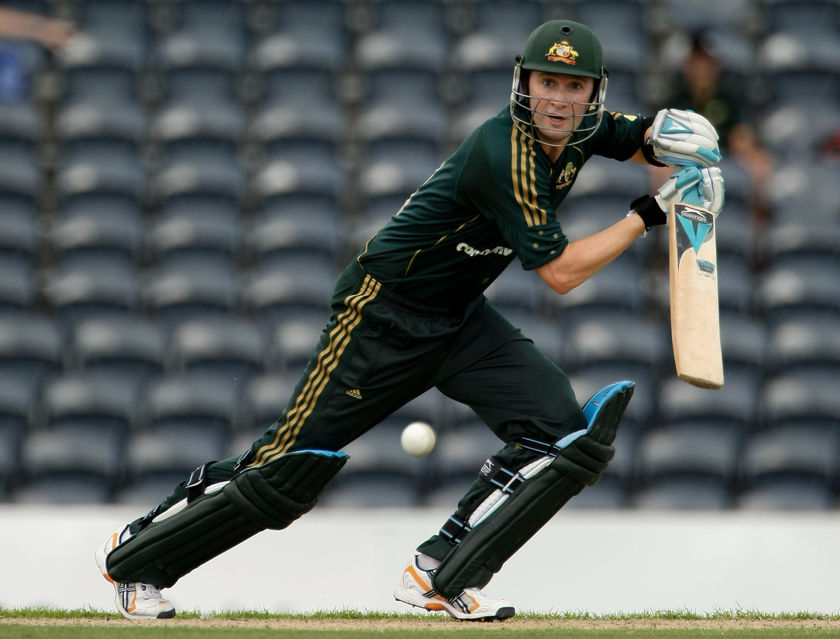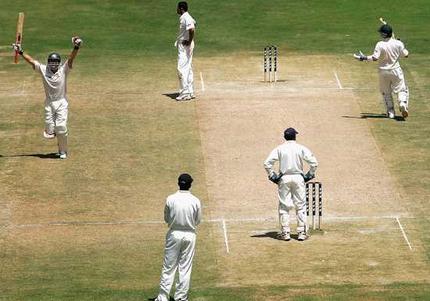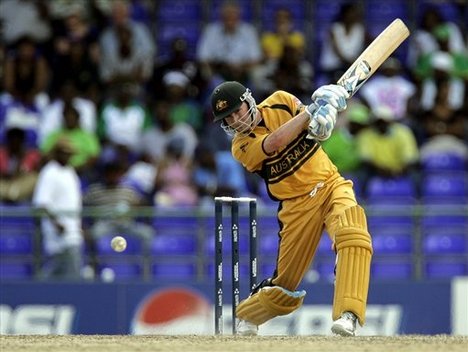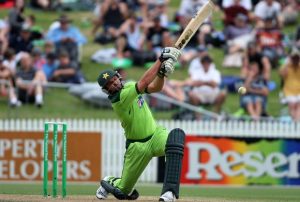Mark Taylor, the former Australian skipper once said that “Michael Clarke is definitely a future captain for Australia”.

This came at perhaps the most turbulent time of Clarke’s career, when he was dropped from the team following a poor Ashes series in England in 2005, with Australia also looking to adopt a 6 batsmen and 5 bowlers strategy. Many predicted that Michael Clarke might end up as one of the saddest stories of Australian cricket, but Taylor was proven right six years later when Clarke was actually appointed to lead Australia on a permanent basis after the World Cup 2011 following Ricky Ponting’s much publicized resignation from the post. This speaks oodles of the talent “Pup” as he is affectionately called, possesses.
Michael John Clarke was born in Liverpool, New South Wales on April 2, 1981. As a result, he had the advantage of being bought up in an environment which favoured him taking up cricket as his profession, since the sport was his passion like many other young Australians. Since New South Wales has had this undying reputation of producing some of the finest players to have taken the cricket field for the Australian national team, since they have won the most number of Sheffield Shield titles (which is equivalent to India’s Ranji Trophy) in the domestic competition in that country more than any other province.
He made his debut as a 19-year old for New South Wales in the Sheffield Shield and made such a massive impact as a batting all-rounder, that he was selected in the Australian ODI squad for the home triangular series against England and Sri Lanka. His debut was against England at Adelaide on January 19, 2003, which meant that it took him a mere three years to make a name for himself and grab the attention of the Australian selectors. He made an immediate impact in that game, bowling 7 overs giving only 24 runs away and picking up a wicket as well as hitting an unbeaten 39 runs off 47 balls in Australia’s successful run chase of 154.
However, he was not considered in the ODI squad for the World Cup 2003 with Australia’s one-day team being too strong at the time. Yet fate had something big in store in for him, and that was a consistent place in the ODI team post World Cup. He played in the last three ODIs against the West Indies in the West Indies, after Australia had won the first four games. He hit two unbeaten fifties in those matches, batting at No.5 and that helped his cause, although they did not help in the team winning.
Michal Clarke’s Best Moments
The first was the day he made his Test debut, achieving the Baggy Green. It was against India in Bangalore in the first Test of the Border-Gavaskar Trophy in October 2004.

He came into bat at No.6, with Australia being 149/4 at one stage. He alongside with his now alleged foe, Simon Katich resurrected the batting ship. He made a century on Test debut and that too in unfavourable Indian conditions, with the opposition attack comprising of Harbhajan Singh and Anil Kumble, who were in their prime, Irfan Pathan who was an emerging bowler and ofcourse Zaheer Khan, the bowling spearhead. His 151 came off just 248 balls, and in the style in which he attacked the spinners reminded many Australian fans of Doug Walters and Mark Waugh, to a certain extent.
The innings was off controlled aggression as he was calculative in taking risks, which was impressive considering this was his debut match. Australia went on to win by a huge 217 run margin, as that knock proved to be the biggest difference between the two sides. It also laid the platform for a series win in India for the first time in 35 years, that too without Ricky Ponting’s services in three of the four Tests and in the process making the Border-Gavaskar Trophy board a flight back to Australia.
The 151 showed his batting abilities, and a prelude to his success to be one of the rare Australian batsmen to play spin bowling very well. However, when it was his turn to bowl spin, he was not left far behind in the same series. In the final Test at Mumbai, the Wankhede wicket was a complete turner as it was likely to deteriorate big time by the time of the third innings of the match. Clarke, who was brought on to bowl by Ponting, as late as the 57th over struck almost instantly with the big wicket of the captain Rahul Dravid who was miserably out of form. In his next over, he picked the wicket of wicketkeeper Dinesh Karthik and two overs later, of Mohammad Kaif.
With all the recognized batsmen gone, Clarke wrapped up the Indian tail single-handedly to bowl out India for 205 in the second innings after being 153/4 at one stage. He took full advantage of the nature of the pitch and therefore has the record of being one of the quickest bowlers of all time to pick six wickets in a Test innings and giving away the lowest number of runs in the process. Australia were left to chase 107 and although they could not win in the end, yet Clarke’s spell was one of the hot topics in cricketing circles during that period of time. Since then, Pup has been considered as the man with the ‘golden arm’ for his sudden wicket-taking ability, and consequently Ponting relied on his bowling during his captaincy.
The second was in 2010 that Clarke proved why he is a batsman who relies more on his mental strength rather than his physical. Prior to the first Test against New Zealand in Wellington, Clarke had confirmed his break up with his model girlfriend Lara Bingle as he was traumatized to see her naked pictures in a women’s magazine in relation to her former boyfriend. You can imagine the turmoil he would have been in, considering that he was engaged to this woman and so madly in love with her. But he did not allow his focus to deteriorate, believing in his abilities and in that Test match, he scored 168 off just 253 balls against an attack which is definitely not the best in the world, but capable enough to trouble Clarke who was not in the best frame of mind. More importantly, Australia went on to win the Test match and was an indication of his transformation as a Test batsman who was earlier carried away with playing shots to a batsman who valued his wicket 100 times more.
His 168 in Wellington was his highest Test score until January this year when he hit his magnum opus innings of an unbeaten 329 off just 468 balls against India at his home ground, the Sydney Cricket Ground (SCG) in the second Test match. It was a majestic knock as Clarke dominated the Indian bowlers right from the word go, after Australia were wobbling at 37/3 at one stage. His aggressiveness did not seem to stop for once and made the bowlers hapless by the end of it all. It showed his big scoring appetite which has increased ever since he has been captain, enjoying the responsibility thoroughly and also his status as one of the best batsmen in world cricket, especially in Test cricket at the moment.
Clarke is a reflection of both Ricky Ponting and Mark Taylor as captain, having learnt the tricks of the trade from Ponting in the initial years of his career. His 329 was scored quickly enough that he had a golden opportunity to break Brian Lara’s record of 400 in a Test innings, with loads of time left in the match. Yet, Clarke went on to declare the innings at 659/4 after allowing his out of sorts teammate Michael Hussey to complete his 150.
He believes that the team is greater than the individual when it comes to his leadership for Australia, and since the bowlers would have needed time to bowl out India’s powerful batting line-up in improving batting conditions, he felt that sacrificing his personal achievements was the best thing to do in that situation. Australia won the game in the end, with India bowled out for a huge 400 in the second innings. This is why he commands respect from Australia and the cricketing world, irrespective of his brash and happy-go-lucky lifestyle off the field.
He followed that 329 with 210 in Adelaide, therefore making him the first player since Sir Don Bradman and England’s Wally Hammond to score both a triple century as well as double century in the same Test series. His credibility as one of Australia’s most reliable Test batsmen is a foregone conclusion, as he was also able to cover up for his poor performances in the 2005 Ashes series in the 2009 edition in testing conditions in England with 448 runs in 5 Tests. Although Australia lost that series too, Clarke was declared man of the series on the recommendation of England coach Andy Flower for his ‘excellent batting’, at the time when no other batsman in general stepped up for the team.
When it comes to captaincy, Michael Clarke first led Australia in a Twenty20 international against New Zealand at Perth in late 2007, proving that the selectors had a vision to see him leading the team in the near future. Come 2009 and he was appointed as a regular skipper in T20s following Ponting’s retirement from the format of the game and led the team for 18 months, until he decided to follow Ponting’s footsteps and the fact that his natural style of batting is too unhelpful in T-20 cricket and not in Tests and ODIs, which became his main focus ever since.
In ODIs, he was appointed captain for the first time for the 4th and the 5th one-dayers respectively on the tour of West Indies in May 2008. Since then, he had done a good job being a stand in captain in case Ponting was not available or injured. Looking at his success, the Australian selectors named him captain for the 5th Test against England in Sydney in January 2010 after Ponting was apparently rested after being 1-2 down in the 4 Tests which had been played already.
But the moment he began leading Australia full time, he has led his team to ODI series wins in Bangladesh (3-0 in 3 matches), Sri Lanka (3-2 in 5 matches) and South Africa (2-1 in 3 matches) which is a terrific comeback from the team following a disastrous World Cup 2011. And in Tests, he oversaw his team winning in Sri Lanka, a huge achievement considering Australia’s misadventures in the Indian subcontinent by a 1-0 margin in 3 Test matches. He hit a match-winning 60 runs off 80 runs in the first Test at Galle and a match-saving 112 in the final Test at Colombo, showing his return to form in this version of the game following a disastrous Ashes series at home not too long ago.
Followed by which, the team toured South Africa and squared the 2 Test series, 1-1 which was another fighting effort from the Aussies after they were the underdogs in the eyes of many to win the series. Clarke’s 151 in the first Test at Cape Town was one of the best Test innings of 2011 with the conditions completely bowling-friendly and the skies being cloudy for the most of the first day. It single-handedly led Australia to a total of 289, but unfortunately he had to be made the scapegoat of the team’s sensational batting collapse of 47 in the second innings.
Clarke himself said that the 151 was useless and not worth to remember, if it did not help the team win which again showed his maturity as a cricketer, now that he has to be at the centre of his team’s successes and failures. But the second Test at Johannesburg was a thriller, in which the team admirably chased down 310 in the second innings to win the game. However, one of the lowest points of his career was to see Australia lose to archrivals New Zealand in a home Test, which was at Hobart in December 2011.
Yet, the team was fortunately undeterred when it came to playing India and now the morale has completely changed, with Clarke proudly leading an Australian team which whitewashed India in their own backyard, 4-0 in 4 matches with he being declared the player of the series. With this win, he has not lost a Test series as captain as yet, therefore playing an instrumental role in the process of getting the side back to the top of the ladder in world cricket in both Tests and ODIs.
What is also enlightening about his captaincy is that he is making full use of his powers as selector in the positive manner. He has persevered with senior and aged players such as Ricky Ponting, Michael Hussey and Brad Haddin despite the trio being woefully out of form for a while now. And that perseverance has paid off, with Ponting scoring 544 runs in 6 innings against India recently, while Hussey ended with 293 runs in as many innings. Haddin is still under some pressure, but at the moment he is the most competent wicketkeeper to play at international level in the short run and his batting abilities cannot be underestimated. Clarke realizes that if Australian cricket has to move forward, the team has to have wise heads especially Ponting, who now plays the role of Sachin Tendulkar for Australia, being a mentor as well as the numero uno batsman of the team, and not to mention giving vital inputs to Clarke in terms of how to about leading this team to glory.
His style of captaincy on the field is also energetic, as he likes to make the game more forward which gives Australia more chances to enforce a result rather than getting bogged down at any stage of the game and giving up hope. Apart from the encouragement he gives to his bowlers, Clarke is extremely aggressive which gives an incentive to the bowlers to pick wickets rather than contain the run flow. His support for Nathan Lyon has also been tremendous, and the team was rewarded with a four-wicket haul from him in the second innings of the recently concluded Adelaide Test against a batting line-up which is renowned to play spin exceptionally well. The team has also become more passive in terms of sledging, although at Adelaide, Ben Hilfenhaus had an unpleasant exchange of words with Virat Kohli. All these are the ingredients for Clarke to become one of the finest captains of Australia in the near future.
Michael Clarke in the World Cup
When it comes to World Cups, Pup has represented his nation in two editions of the tournament, in 2007 and 2011. Individually, both of them ended successfully for him as he seems to revel under the pressure of playing at the grandest stage of them all.

In the 2007 competition in the West Indies, Clarke proved his stature as a key member of Australia’s ODI batting line up with two fifties on the trot against The Netherlands and more crucially, South Africa in the group stages. In the Netherlands game, he hit 93 runs off just 85 balls remaining not out till the end, at a strike rate of 109.41 which included six fours and three sixes. Australia ended at a massive 358/5 in 50 overs, and eventually won by 229 runs. Come South Africa which was the marquee clash of all and Clarke hit 92 in much lesser balls, 75 of them at a strike rate of 122.66, which included as many as seven fours and four sixes. Australia ended at 377/7 in 50 overs, a much better effort than the last game and won by 83 runs.
He did not score any century throughout the tournament but his forties and fifties were crucial to Australia who relied on their batting to deliver the goods more often than not. His 47-ball 41 against the West Indies and an unbeaten 63-ball 55 against England in the Super 8 round came in critical junctures as he played the role of a finisher with panache. His joy ride lasted till the semifinal against South Africa where he guided the team home with 60 not out off 86 balls in a run chase of a mere 150, as Australia crushed them by 7 wickets to qualify for the final. Clarke ended with 436 runs in the tournament, which is lower than Hayden and Ponting’s aggregates but every run of his counted in Australia winning the title for the third time in a row.
In 2011, the World Cup was played in the Indian subcontinent and just before the competition, Pup retuned to form following two half centuries against England in the last two ODIs of the home series which the team won 6-1 under his captaincy. His confidence had returned and Australia needed it desperately, since this time around the batting was not so strong to bring in fear in the opposition bowling attack and the fact that Michael Hussey was injured for the group games and captain Ricky Ponting was out of order. Clarke was the batting spearhead and he lived up to that tag immediately with a 58 not out against Zimbabwe in the first round-robin match they played in the tournament. The innings came in only 55 balls and was the key in Australia eventually ending with 262/6 in 50 overs, after being at 144/3 in 33 overs. Australia went on to thrash the minnows by 91 runs in Ahmedabad, giving them an ideal start to their title defence.
That was followed by an unbeaten 24 against New Zealand in Nagpur, in which he was not required to contribute much since the Kiwis were bowled out for 206, leaving the team too modest a target to chase. The next game was against another pushover team, Kenya at Bangalore and Clarke ironically had to depart from the crease, with yet another score in the nineties in World Cup cricket. His 93 off 80 balls was crucial in Australia getting to 324/6 in 50 overs, ending up with a 60 run victory with the bowling being a bit rusty.
But after that innings, there was hardly any scintillating display of batting from him with an aggregate of 58 runs in the next three matches against Canada, Pakistan and India. He could have gone on to play a big knock against Pakistan in what was a must win game for the team to gain an easy quarterfinal draw, but was out for 34 off just 48 balls. With Australia getting knocked out from the tournament following their defeat to India in the quarterfinals, the tournament ended for Pup with 233 runs in 6 matches.
On aggregate, in World Cups Clarke has so far scored 661 runs in 15 innings at an average of 44.06. In all likelihood, he will be leading Australia in the next edition of the championship which will be held at home and New Zealand would be the joint hosts. By then, he should be able to forge a team which can again become world beaters and what should give them inspiration is that they are still the World No.1 team as per the ICC rankings, so they have to live up to that by playing consistently outstanding cricket. So, he would look forward to have a much better outing the next time around both as captain and batsman.
Michael Clarke’s ODI Records
He has appeared 206 times for his country in this format, amassing 6622 runs having played 188 innings, averaging 45.35 and has hit these runs at a strike rate of 78.10. These numbers sound perfect for a middle order batsman who bats at No.4 or No.5 usually for the team and since Clarke relies more on building his innings rather than attacking from ball one, this strike rate is decent enough for him to contribute big runs for the side. His average is one of the best amongst ODI batsmen in the contemporary era to have played more than 100 innings and outstanding because it means that even if he bats in the middle order, he scores 45 runs in one game.
Unfortunately, he only had 6 one-day hundreds to his name, which does not speak of his skill. But all that have come have been special knocks. His first was against Zimbabwe in Harare in May 2004, having played 16 months of ODI cricket. He opened the batting for Australia in the absence of Matthew Hayden and hit a 102-ball 105, remaining not out till the end even as he hit 16 fours and 1 six in the innings. The match was won by 8 wickets.
The second one came against Pakistan in January 2005 in the traditional triangular series at home at the start of the year. This was at the Sydney Cricket Ground, his favourite and his home ground. He yet again opened the batting for Australia in this game with this time, Adam Gilchrist being conspicuous with his absence. Only his innings of a 103 not out off 107 balls was enough to make meat off an incompetent Pakistani bowling attack, as he hit 14 fours and 1 six throughout the knock. Australia went to win by 9 wickets chasing just 164 to win in 50 overs.
In his initial years, he was asked to open the batting for Australia at times. But then the team gradually realized his potential as a No.4 batsman and following the phasing out of some greats as well as non-performers, Clarke cemented that spot in the team. In this backdrop, his third ODI hundred was hit against India at incidentally the same venue where he hit a Test hundred on debut, at the Chinnaswamy Stadium in Bangalore. His 130 came off just 132 balls, as he played an epic knock to demoralize an Indian side which had recently won the World T-20. Clarke came into bat in the fourth over of the innings and was dismissed on the last ball of the 50th over. In that time, he hit ten fours and three sixes at an impressive strike rate of 98.48. The team finished at a score of 307/7 in 50 overs, but unfortunately the match ended without a result due to rain.
His next century was against Pakistan in Abu Dhabi in the fourth ODI of a five-match series. Once again, he remained unbeaten till the end of the innings scoring a 100 off 122 balls as Australia chased down a total of 200 runs successfully with five overs to spare. This has been one of his finest ODI hundreds since he was captain of Australia in this game and more importantly, the hundred sealed the series for Australia by three games to one, with one to play giving them an away series win.
In October 2010, Australia toured India for a short period of time, playing just 2 Tests and 3 ODIs. Australia had just lost both the Tests and to prepare for the Ashes, some of the senior players including Ponting were rested. So Clarke was again handed over the leadership reins, but this time of a rookie team to play India in their backyard. The first match was washed out due to rain in Kochi, so the focus was on the second game at Vishakhapatnam (Vizag).
Australia batted first after being sent in by captain MS Dhoni, and were in early trouble being 11/1 in 3.5 overs when Clarke came into bat, this time at No.3. He made good use of the batting conditions, hitting a 139-ball 111 and yet again staying unbeaten till the 50th over, which is an amazing statistic. He played the role of staying at the wicket for the longest possible time, while his other batting colleagues would look to increase the run rate. Australia finished at 289/3 in 50 overs, but India chased down the total which handed Australia a 5 wicket defeat and that was the end of the series as well with the last match also being a no result.
And lastly, his sixth ton came against Bangladesh in Dhaka in April 2011 in the first ODI the team played after the World Cup and Clarke’s first as the permanent leader of the team. He hit 101 off just 111 balls, while there was no other significant contribution from the rest of the batting crop. Australia ended at 270/7 in 50 overs, which was more than adequate against the minnows, giving them a 60 run victory to go 1-0 up in the series.
In terms of bowling in ODIs, he has only picked 52 wickets since Australia does not need his services as much in the 50 overs due to the dearth of bowlers they have possessed in the duration of his year. But when asked to bowl, he can rip apart a batting line-up and a testimony to this fact is when he achieved figures of 5/35 in 7.5 overs against Sri Lanka in Dambulla in February 2004 and 4/42 in 10 overs in once again, Mumbai against India in November 2007. While on the field, he has taken 80 catches and inflicted innumerable run-outs with his deadly accuracy and quick reflexes, especially fielding at backward point.
Michael Clarke’s Test Cricket Recrods
Even in Tests, his fielding standards have remained high with 89 catches in 80 Tests. In terms of bowling, he has had 24 wickets to his name so far in his career and 12 of those have come against India with his famous spell being the 6/9 in 6.2 overs in Mumbai but apart from that, he also took 3 wickets, that of Ishant Sharma, Harbhajan Singh and RP Singh on the final day of the controversial Sydney Test match of 2008 with 8 minutes remaining for India to bat for the draw. Those wickets helped Australia win the match and go 2-0 up in the series. And more recently, he denied Sachin Tendulkar his much anticipated 100th ton by dismissing him for 80 in the Sydney Test this year.
But when it comes to his batting, there is no doubt that Clarke has all the ingredients in the making to become one of the greatest the game has produced, if not legendary. In the initial years of his career, he could clear boundaries and loft regular fours as if it was a cakewalk for him but now he has evolved to change his method. That of finding gaps by caressing the ball along the ground, although he will pull off the front foot once he is comfortable at the crease. With elegant shots across midwicket and lovely cut shorts, Clarke is mostly known for his immaculate driving and slicing of the ball through impossible angles making him a run machine for the side.
He has scored 5909 runs in 80 Test appearances, averaging 49.65 in the 132 innings he has batted; with the highest score of 329 not out against India at Sydney this year. He has played for over eight years now and at this rate, it is likely that he will cross the 10,000 mark in the years to come and the fact as that as long as he is captain, his batting levels would actually rise as seen in the last six months or so. He has had 19 hundreds and 21 fifties, which is a proof of his consistency despite being in a slump from December 2004 – December 2005 and July 2010 – January 2011.
Due to his 151 against India in Bangalore, he ended with 410 runs in four Tests in the Border Gavaskar Trophy which the team regained, by a 2-1 margin as he played an excellent supporting role to the in-form Damien Martyn. His second Test century though came in the next series against New Zealand which was at home. He scored a 141 at brisk pace, off just 200 balls to hand Australia an innings victory and a lead in the Test series.
He had to wait for two long years to get his next Test hundred as it came against England at Adelaide in the second match of the Ashes series at home. The 124 off 224 balls marked his return into international cricket and assured him a regular Test place in the side; with Martyn retiring after this game which Australia won dramatically by 6 wickets to go 2-0 up in the series. He backed that effort up with yet another century in the next Test at Perth, in the second innings as he was involved in a characteristically huge partnership with Adam Gilchrist. Clarke would cherish this hundred more since it came in difficult batting conditions at the WACA. His unbeaten 135 off just 164 balls ensured that Australia won the Test by 206 runs and regain the Ashes.
There were two more hundreds to come in the home summer next year, against Sri Lanka and India. Australia played the Lankans in traditionally where the first Test the team plays at home every year, at The Gabba in Brisbane. He ended with 145 not out off 249 balls, batting at No.5 and yet top scoring the innings despite two batsmen above the order scoring centuries. His performance led Australia to a colossal total of 551 for 4 declared and led to another victory by an innings and 40 runs.
Against India though, the situation was tense following the controversial Test match in Sydney and India winning at Perth, giving them all the chances to level the series. Clarke comes out in the final Test at Adelaide, pressurized by India’s 526 runs on the board and still goes on to score a patient knock of 118 off 243 balls, rare in those days to see from him. With Ponting and Hayden also scoring tons in terrific batting conditions, Australia piled up 563, getting a lead of 37 runs and ensuring that the match is a draw and they won the series 2-1.
2008 saw him score three hundreds, two of them being in overseas series in West Indies and India. In the West Indies, he scored a 187-ball 110 in the very first Test at Antigua. The hundred was extremely crucial for the Australians to achieve a crucial first innings lead of 127 runs, as West Indies had to fight it out for a draw in the end. The next series Australia played was in India, but this time around Pup struggled for most of the tour except the first innings of the third Test at Delhi. On what was a flat pitch, this was Clarke’s best opportunity to score big and he made it count with a 253-ball 112, in the process top scoring the innings which ended at 577 all out. This was another drawn game but Clarke would be proud of the fact that in three tours of India, he has scored two hundreds which not many contemporary Australian batsmen have been able to do.
The last one of 2008 was one more ton against the Kiwis and this was his third ton at Adelaide out of his nine Test tons at that stage overall. He could not carry on making a 150 for the umpteenth time, being dismissed for 110 off 239 balls. But more importantly, the knock won Australia the Test match by an innings and 62 runs leading to a 2-0 whitewash. And also the fact that he was ready for a fine series against South Africa at home.
He began 2009 in style despite Australia losing the previous 2 Tests against the Proteas. The last Test at Sydney meant Australia had their pride at stake for not being whitewashed at home and being his home ground, Clarke wanted to make an even bigger impact despite being in good form throughout the series. He hit a 250-ball 138 in the first innings to guide Australia to a decent score of 445 all out, which turned out to be vital in their 103 run victory to lose the series 1-2 rather than 3-0.
He had an average tour of South Africa but covered up for it in the Ashes in England, where he hit two more hundreds. But it took him six months for him to get a three digit score, and it was against Pakistan in the final Test of the home summer in Hobart. Alongside Ponting’s 209, Clarke’s 166 off just 328 balls made Australia declare at 519/8 in the first innings to set up a 231 run to whitewash Pakistan 3-0.
But at the time, he was also trauma in his personal life as his relationship with his fiancé worsened but he emerged stronger from it, making Australia his No.1 priority since then. His 168 at Wellington could be rated as one of his best ever considering the situation he was in at the time. However, that was his last century until he was made captain and that was the signal for him to change his style of batting.
Since being skipper, he has scored as many as 5 hundreds in 10 Tests. He has taken inspiration from Australian captains in the past such as Sir Don Bradman, Mark Taylor, Steve Waugh and Ricky Ponting to be a more responsible rather than carefree batsman, but still sticking to his natural game. In Clarke’s case, it is to keep rotating the strike but at the same time being at the crease for as much time as possible. With his approach and being just 30 years of age, Clarke is likely to have more and more runs under his belt as this is the appropriate time for him to experiment batting at No.3 atleast in Tests, if not ODIs.
Controversies
I still cannot figure why the Australian public and media has had a love-hate relationship with him over the years. Maybe because of his number of brand endorsements or his much discussed about personal life with his desire for having an attractive girlfriend never ending, having a model girlfriend in Lara Bingle or his current girlfriend, Kyle Boldy being a TV presenter cum model.

Or the fact that he is so particular about his looks or being fresh that one teammate of his says that he takes a shower six times a day.
Besides, even in cricket Clarke most recently was accused of being responsible for ending veteran opener Simon Katich’s Test career, due to one of their ugly spats on the tour of South Africa in 2009 which soured relations between them. Katich was not awarded a central contract in 2011, and as a result he believed that unless Clarke remains captain of Australia, he cannot play for the country again.
Many would say that Michael Clarke has to bury the past and accept the present by forgiving Katich, for the sake of Australia rather than personal reasons. But there has been enough evidence that Clarke has not misused the powers he has been bestowed, for leading the side and has been just in his selection policies and team strategies so far. So it is unfair for the media and public alike to blame Clarke for some issues which have gone wrong in Australian cricket and instead he should be respected or atleast appreciated for his opinions on taking the side forward to world glory. Irrespective of the fact that off the field he is brash or seems to pay more attention to his personal life.
I would say that is Michael Clarke’s choice to lead life the way he wishes to, but as long as he is leading Australia in a positive direction, he should not be criticized and following the success against India, he would not be.






Leave a Reply